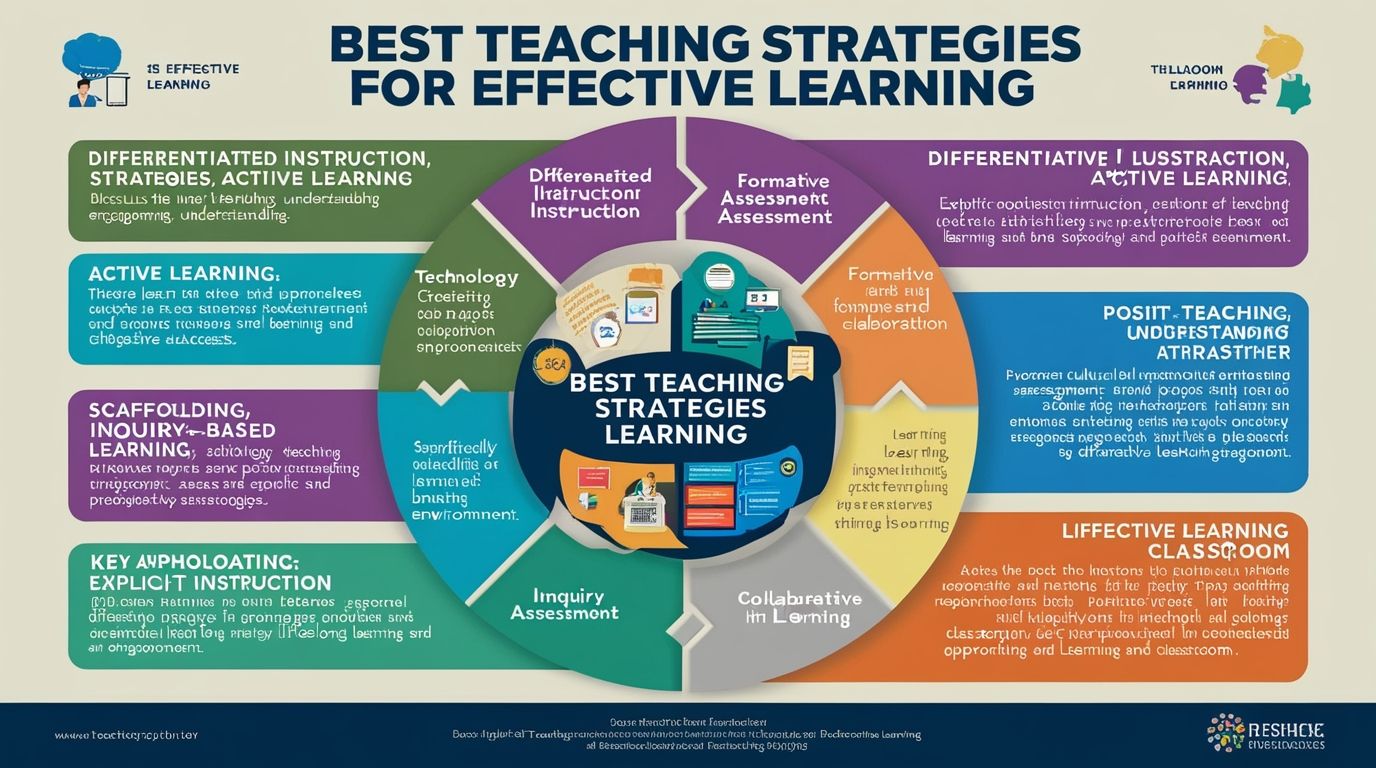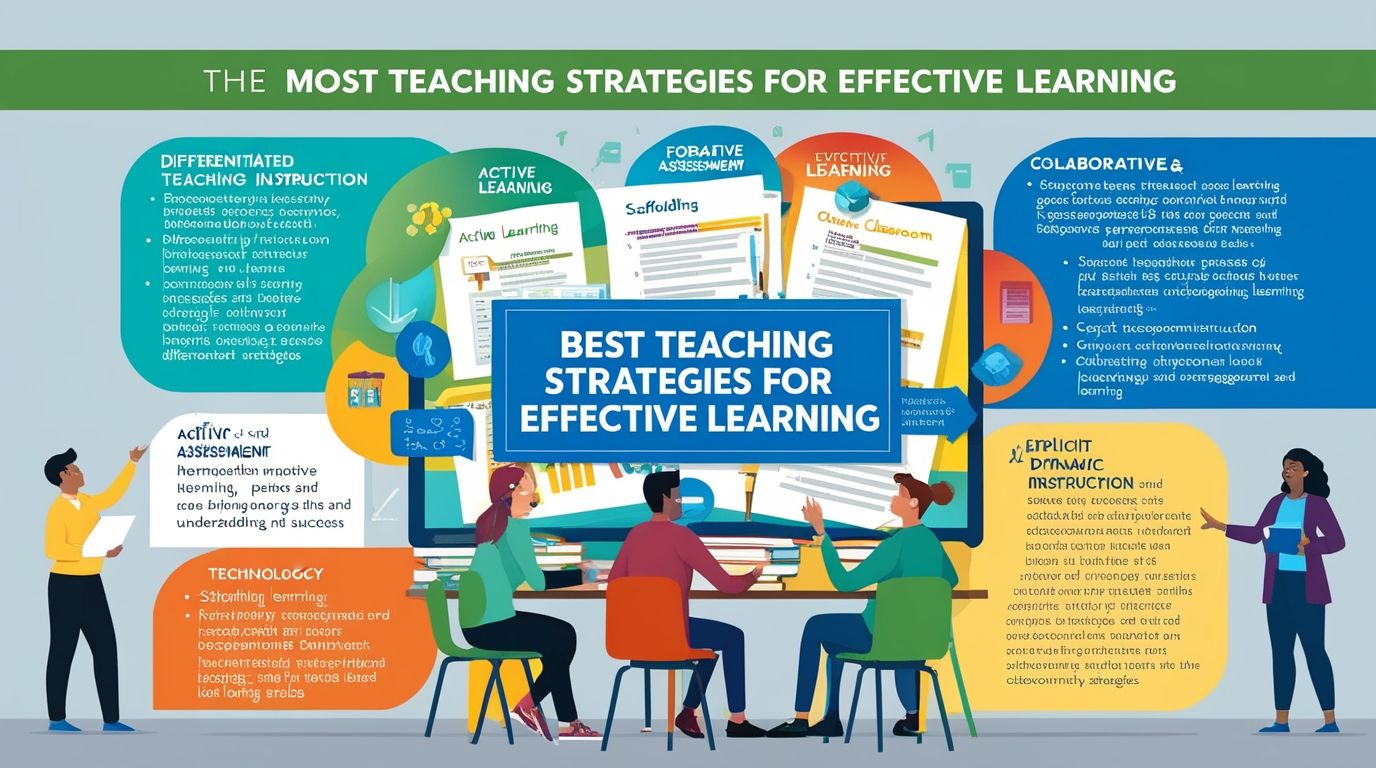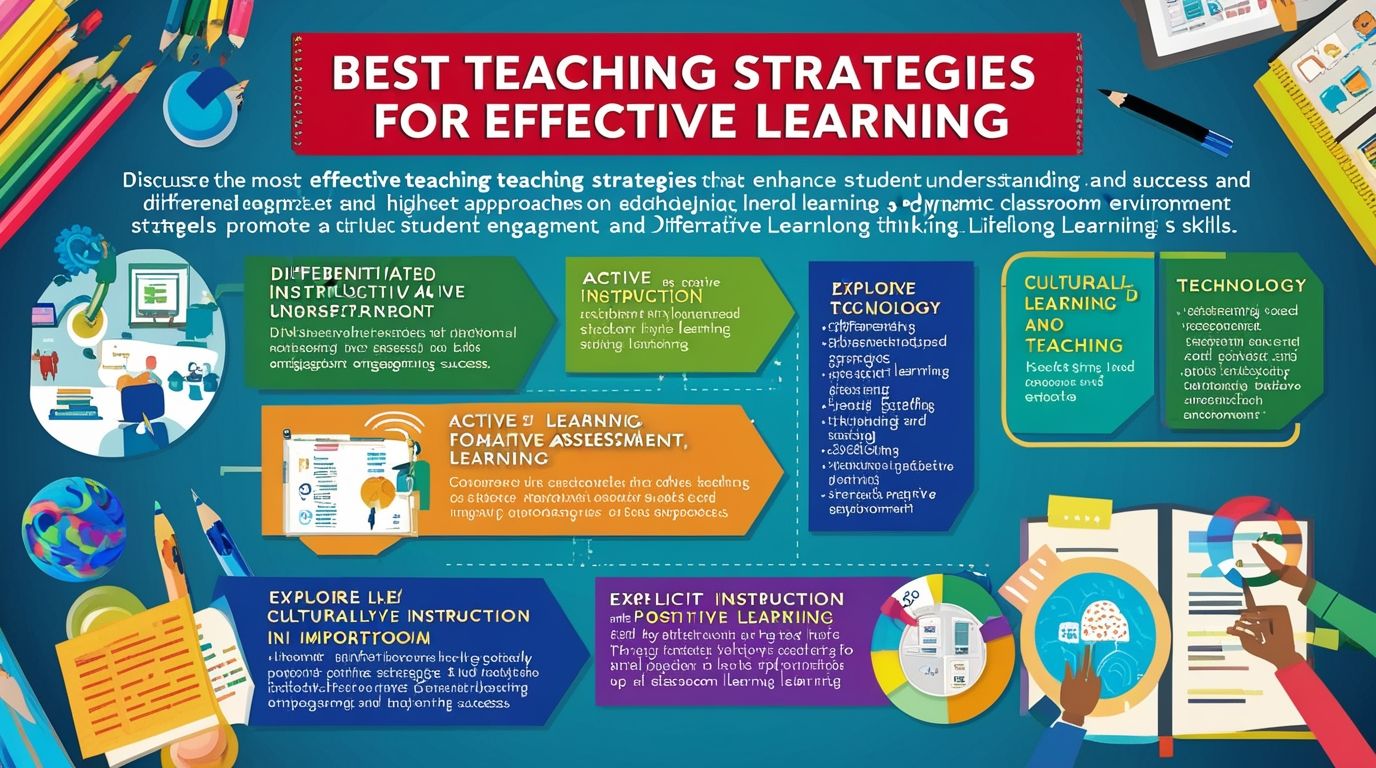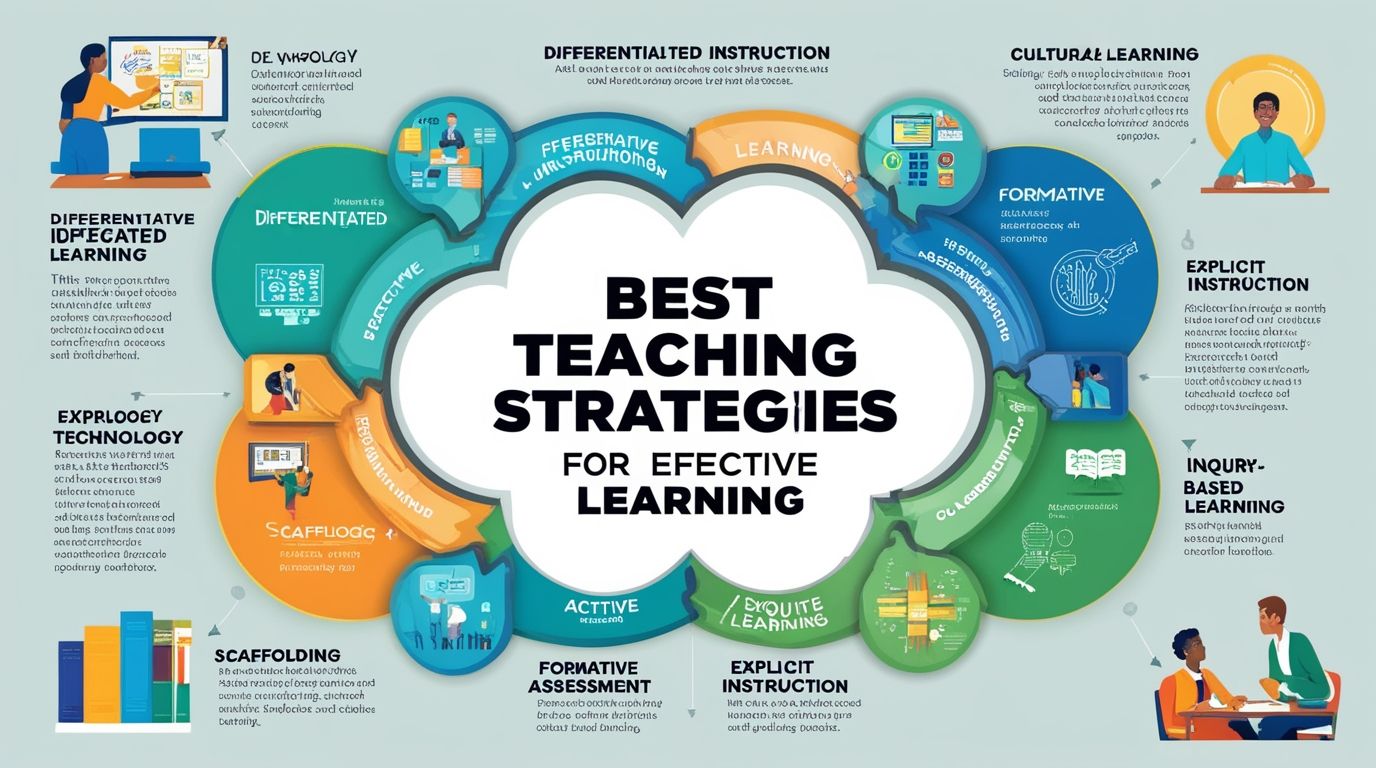Best Teaching Strategies for Effective Learning Teaching is both an art and a science that requires a thoughtful combination of strategies to meet the diverse needs of learners. Effective teaching strategies engage students, enhance understanding, and foster a positive learning environment. In this article, we will explore some of the best teaching strategies that educators can use to promote active learning, critical thinking, and student engagement.
1. Differentiated Instruction
Differentiated instruction is a teaching approach that tailors instruction to meet the diverse needs of students. Recognizing that students have different learning styles, abilities, and interests, this strategy involves varying the content, process, and products of learning.
- Content: Providing different materials or activities to cater to varying levels of understanding.
- Process: Offering choices in how students engage with the material, such as through hands-on activities, visual aids, or group discussions.
- Products: Allowing students to demonstrate their understanding in different ways, such as through essays, presentations, or creative projects.
Differentiated instruction ensures that all students have access to the curriculum in a way that is meaningful to them, promoting greater engagement and success.
2. Active Learning
Active learning involves strategies that engage students in the learning process directly, encouraging them to participate actively rather than passively absorbing information. Techniques include:
- Think-Pair-Share: Students think about a question individually, discuss their thoughts with a partner, and then share with the larger group.
- Problem-Based Learning (PBL): Students work on solving real-world problems, which helps them develop critical thinking and collaborative skills.
- Flipped Classroom: Students learn new content at home through videos or readings, and class time is used for discussions, problem-solving, and applying knowledge.
Active learning shifts the focus from teaching to learning, making students active participants in their education.

3. Formative Assessment
Formative assessment refers to a range of formal and informal assessment procedures employed by teachers during the learning process. These assessments help teachers identify areas where students struggle and adjust their instruction accordingly. Examples include:
- Exit Tickets: Quick prompts that students respond to at the end of a lesson to gauge their understanding.
- Quizzes: Short, low-stakes quizzes that provide immediate feedback.
- Peer Assessment: Students evaluate each other’s work, which can promote self-reflection and critical analysis.
Formative assessments help create a feedback loop where teachers can continuously improve their instructional strategies and students can monitor their own learning progress.
4. Collaborative Learning
Collaborative learning involves students working together in groups to achieve learning goals. This strategy not only fosters teamwork but also encourages communication, problem-solving, and critical thinking skills.
- Group Projects: Students collaborate on projects that require them to research, create, and present as a team.
- Peer Tutoring: Students help each other understand concepts, which can reinforce their own understanding.
- Jigsaw Technique: Each student in a group becomes an expert on one part of a topic and then teaches it to their peers.
Collaborative learning leverages the strengths of each student, creating a richer, more inclusive learning experience.
5. Use of Technology in the Classroom
Technology can enhance learning by providing interactive, engaging, and personalized experiences. Incorporating technology in the classroom can take many forms, including:
- Interactive Whiteboards: These allow teachers to display multimedia content, which can make lessons more dynamic.
- Educational Apps and Games: Tools like Kahoot!, Quizlet, or Duolingo make learning fun and interactive.
- Online Collaboration Tools: Platforms such as Google Classroom or Microsoft Teams facilitate communication, assignment submissions, and feedback.
By integrating technology, teachers can cater to different learning styles and make content more accessible and engaging.

6. Scaffolding
Scaffolding is a teaching strategy that involves providing temporary support to students as they learn new concepts. This support is gradually removed as students become more proficient. Techniques include:
- Modeling: Demonstrating a task or process before asking students to complete it independently.
- Guided Practice: Working through problems together with the class before students try on their own.
- Prompts and Hints: Offering cues or reminders to help students think through a problem.
Scaffolding helps bridge the gap between what students already know and what they need to learn, making new content more accessible.
7. Inquiry-Based Learning
Inquiry-based learning encourages students to ask questions, explore, and investigate topics deeply. This strategy promotes curiosity and a deeper understanding of the subject matter.
- Project-Based Learning: Students work on projects that require them to investigate a question or problem.
- Socratic Seminars: Discussions that involve asking and answering questions to stimulate critical thinking and draw out ideas.
- Exploratory Activities: Students conduct experiments, research, or explorations to learn about a topic.
Inquiry-based learning empowers students to take ownership of their education and develop lifelong learning skills.
8. Explicit Instruction
Explicit instruction is a systematic, direct teaching method that includes clear, structured, and sequenced steps. This strategy is particularly effective for teaching new concepts or skills.
- Clear Objectives: Clearly stating what students will learn and why it is important.
- Modeling: Demonstrating the skill or concept in a step-by-step manner.
- Guided Practice: Providing opportunities for students to practice with support and immediate feedback.
- Independent Practice: Allowing students to practice independently once they are ready.
Explicit instruction is highly effective in building foundational skills, especially in subjects like math and reading.
9. Culturally Responsive Teaching
Culturally responsive teaching involves recognizing and honoring the cultural backgrounds of students in the classroom. This strategy aims to make learning more relevant and accessible to students from diverse backgrounds.
- Incorporating Diverse Perspectives: Using materials and examples that reflect the diverse cultures of students.
- Building Relationships: Understanding and valuing students’ cultural identities to create a more inclusive classroom environment.
- Connecting Learning to Students’ Lives: Relating academic content to students’ real-world experiences and cultural contexts.
Culturally responsive teaching helps create a supportive learning environment where all students feel respected and valued.
10. Positive Classroom Environment
Creating a positive classroom environment is essential for effective teaching and learning. A supportive atmosphere encourages students to take risks, ask questions, and engage more deeply with the material.
- Clear Expectations: Establishing rules and routines that promote respect and responsibility.
- Encouragement and Praise: Recognizing effort and achievements to build students’ confidence.
- Building Rapport: Developing strong relationships with students to understand their needs and motivations.
A positive classroom environment fosters a sense of safety and belonging, which is crucial for academic success.

11. Flipped Classroom
The flipped classroom model reverses the traditional teaching approach by having students learn new content at home through videos or readings, while class time is dedicated to interactive activities.
- Pre-Recorded Lectures: Students watch video lessons at their own pace.
- In-Class Activities: Time in class is used for discussions, problem-solving, and application of concepts.
- Student-Centered Learning: Emphasizes student responsibility and engagement with the material.
The flipped classroom allows for more personalized learning and makes class time more productive and interactive.
Conclusion
Effective teaching requires a diverse set of strategies that cater to the varied needs of students. By incorporating differentiated instruction, active learning, formative assessments, collaborative learning, technology, scaffolding, inquiry-based learning, explicit instruction, culturally responsive teaching, a positive classroom environment, and the flipped classroom model, educators can create dynamic and inclusive learning experiences. These strategies not only enhance understanding and engagement but also foster a lifelong love for learning.

11 thoughts on “Best Teaching Strategies for Effective Learning”
Comments are closed.